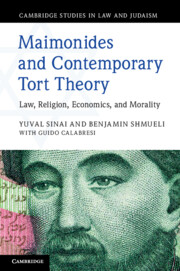Book contents
- Maimonides and Contemporary Tort Theory
- Cambridge Studies in Law and Judaism
- Maimonides and Contemporary Tort Theory
- Copyright page
- Contents
- Figures
- Introduction
- 1 Initial Presentation
- 2 Tort Liability in Maimonides’ Code:
- 3 The Foundations of the Maimonidean Theory:
- 4 The Deontological and Religious Elements of Maimonides’ Tort Theory
- 5 Consequentialist Considerations in the Guide for the Perplexed
- 6 Revisiting the Problematic Texts of the Code in Light of the Guide and Contemporary Scholarship
- 7 Maimonides’ Standard of Care:
- 8 Maimonides as a Pluralistic-Differential Scholar and Contemporary Tort Law Theories:
- 9 Reflections on Maimonides’ Tort Theory
- Index
3 - The Foundations of the Maimonidean Theory:
Different Goals for Different Categories of Damage
Published online by Cambridge University Press: 10 August 2020
- Maimonides and Contemporary Tort Theory
- Cambridge Studies in Law and Judaism
- Maimonides and Contemporary Tort Theory
- Copyright page
- Contents
- Figures
- Introduction
- 1 Initial Presentation
- 2 Tort Liability in Maimonides’ Code:
- 3 The Foundations of the Maimonidean Theory:
- 4 The Deontological and Religious Elements of Maimonides’ Tort Theory
- 5 Consequentialist Considerations in the Guide for the Perplexed
- 6 Revisiting the Problematic Texts of the Code in Light of the Guide and Contemporary Scholarship
- 7 Maimonides’ Standard of Care:
- 8 Maimonides as a Pluralistic-Differential Scholar and Contemporary Tort Law Theories:
- 9 Reflections on Maimonides’ Tort Theory
- Index
Summary
Chapter 3 introduces the foundations of the Maimonidean theory: the scope of tort law, its connection to criminal law, the classification of the different categories of tort law, and the various objectives underlying each of these categories. We argue that understanding Maimonides’s tort theory and providing a complete view of his theory requires three things: An awareness that Maimonides’ theory incorporates various goals and considerations that operate in concert; the understanding that Maimonides introduced different goals for different categories of damage; and a focus both on what Maimonides wrote in his Code and in the Guide and in his other works such as Commentary to the Mishnah and Responsa. In each category of damage one goal (or more) is (or are) more dominant than the others. A fundamental division into different types of torts emerges from the classification of the Book of Torts in the Code: The basic distinction between damages that are caused by a person’s property and damages that are caused by the person himself; the distinction between a person who causes physical injury to another and a person who damages the property of another; and the distinction between regular damage to nuisance and damages to neighbors.
Keywords
- Type
- Chapter
- Information
- Maimonides and Contemporary Tort TheoryLaw, Religion, Economics, and Morality, pp. 80 - 137Publisher: Cambridge University PressPrint publication year: 2020

